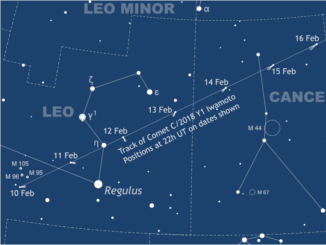
Origin of the Geminids
Discovered in 1983, Apollo asteroid 3200 Phaethon has a highly eccentric orbit with a period of 523.5 days that brings it closer to the Sun than any other named asteroid. Geminids meteors are caused by particles liberated from Phaethon and spread along its orbit encountering our planet’s atmosphere at speeds of around 22 miles (35 kilometres) per second and burning up in an instant due to friction with the air.
The Earth currently encounters Phaethon’s debris cloud between 8 and 17 December, but our planet passes through the thickest concentrations of rocky dust on Monday, 14 December when rates of around 100 meteors per hour can be expected under excellent conditions — and the prospects are for a very favourable shower this year (weather permitting, of course) with new Moon occurring on Friday, 11 December. There will be little interference from a young, 3-day-old waxing lunar crescent setting around 7:30pm GMT as seen from the heart of the UK at the shower’s peak.
Visual appearance
Like the Perseids, Geminid meteors are plentiful (typically 25 percent more events than the former) and offer a high proportion of bright events, but they don’t tend to leave persistent trains like the Perseids. This is due to the rocky nature of the Phaethon debris compared to the somewhat fragile icy material from Comet 109P/Swift-Tuttle forming the Perseid stream.
When to see the most meteors
The radiant — the position in the sky where the Geminid meteors appear to originate — lies near Castor, the upper star of the celestial twins, Gemini, for Northern Hemisphere observers. By the time full darkness descends (around 6pm GMT for the centre of the British Isles), the radiant is already low in the northeast and remains above the horizon throughout the hours of darkness.
While predictions indicate that peak activity will occur at 1pm GMT on 14 December in daylight for the UK, meteor rates will likely still be very high on the nights of 13-14 December (Sunday-Monday) and 14-15 December (Monday-Tuesday). However, given the fickle December weather one should make the most of all clear nights that the shower is active rather than just the nights either side of the maximum.
If you can stay up, the brighter meteors tend to peak around midnight because we are then facing the direction the Earth is moving in its orbit and the relative speed of particles entering our atmosphere is greater.
How to see the most meteors
The faintest meteors are the most plentiful, so to maximise your chances you should find a safe location that is as far removed from streetlights and other sources of light pollution as you can and allow your eyes to become fully dark adapted. Ensure that you are dressed in multiple layers of clothing with warm boots or shoes, gloves and — particularly important — a hat, since a large proportion of heat is otherwise lost through the head.
A thermos flask of your favourite hot beverage and a lounger chair is a good idea as you’ll be still for long periods during your vigil. Observing in company is always more fun too! Don’t concentrate on the radiant but at a point about 40 degrees (or twice the span of an outstretched hand at arm’s length) to one side of it and about half way from the horizon to overhead. Clear skies and enjoy the show!
Inside the magazine
You can find out more about observing the Geminids in the December edition of Astronomy Now in addition to a full guide to the night sky.
Never miss an issue by subscribing to the UK’s biggest astronomy magazine. Also available for iPad/iPhone and Android devices.




